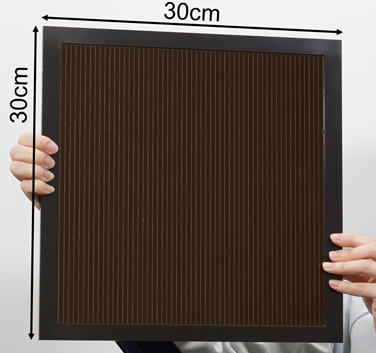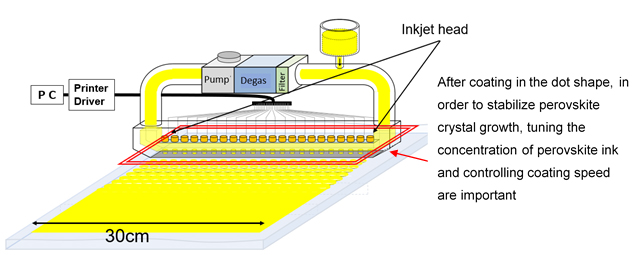Japan’s NEDO and Panasonic Achieve the World’s Highest Conversion Efficiency of 16.09% for Largest-area Perovskite Solar Cell Module
― This Enables High Efficiency Solar Cell Power Generation in Places that were Previously Difficult to Install ―
January 20, 2020
New Energy and Industrial Technology Development Organization (NEDO)
Panasonic Corporation
Kawasaki/Osaka, Japan – Panasonic Corporation has achieved the world's highest energy conversion efficiency of 16.09% for a perovskite solar module (Aperture area 802 cm2: 30 cm long x 30 cm wide x 2 mm thick) by developing lightweight technology using a glass substrate and a large-area coating method based on inkjet printing. This was carried out as part of the project of the New Energy and Industrial Technology Development Organization (NEDO), which is working on the "Development of Technologies to Reduce Power Generation Costs for High-Performance and High-Reliability Photovoltaic Power Generation" to promote the widespread adoption of solar power generation.
This inkjet-based coating method that can cover a large area reduces manufacturing costs of modules. In addition, this large-area, lightweight, and high-conversion efficiency module allows for generating solar power highly efficiently at locations where conventional solar panels were difficult to install, such as façades.
Going forward, NEDO and Panasonic continue to improve perovskite layer materials, aiming to achieve high efficiency comparable to that of crystalline silicon solar cells and establish technologies for practical application in new markets.

1. Background
The crystalline silicon solar cells, which have been most widely used in the world, have found markets in Japan in such fields as mega-solar, residential, factory and public facilities. To penetrate further into these markets as well as secure new markets, it is crucial to make solar modules lighter and larger.
Perovskite solar cells*1 have a structural advantage as their thickness including a power generation layer is only one-hundredth of that of crystalline silicon solar cells, so that perovskite modules can be lighter in weight than crystalline silicon modules. The lightweight property enables various placing styles such as installing on façades and windows by using transparent conductive electrode, which can lead to the wide-spread adoption of Net Zero Energy Buildings (ZEB*2). Further, as each layer can be coated onto the substrates directly, they can be produced cheaper, compared to the conventional process technology. That is why perovskite solar cells are getting attention as next generation solar cells.
On the other hand, despite perovskite technology achieved 25.2%*3 power conversion efficiency, comparable to crystalline silicon solar cells, in small size cells, it was very difficult to deposit materials uniformly all over large-area by conventional technology. As a result, the power conversion efficiency was inclined to decrease.
Against this background, the NEDO is working on the "Development of Technologies to Reduce Power Generation Costs for High-Performance and High-Reliability Photovoltaic Power Generation*4" project to promote the further adoption of solar power generation. As part of this project, Panasonic has developed a lightweight technology using glass substrates and a large-area coating method based on inkjet method including ink producing and tuning applied to the substrate of perovskite solar cell module. Through these technologies, Panasonic has achieved the world's highest energy conversion efficiency of 16.09 %*5 for the perovskite solar cell module (aperture area 802 cm2: 30 cm long x 30 cm wide x 2 mm thick).
In addition, the adoption a large-area coating method using inkjet method in the manufacturing process also enables cost reduction, and the large-area, lightweight, and high-conversion efficiency characteristics of this module enables high-efficiency solar power generation at locations where conventional solar panels were difficult to install, such as façades.
By improving perovskite layer materials, Panasonic aims to achieve high efficiency comparable to that of crystalline silicon solar cells and establish technologies for practical application in new markets.
2. Achievement
By focusing on the inkjet coating method that enables the raw material to be coated precisely and uniformly, Panasonic applied that technology to each layer of the solar cell including perovskite layer on glass substrate and realized high power conversion efficiency for a large-area module.
<Point of technical development>
(1) Improving component of perovskite precursor for suitable for ink-jet coating
Among the atomic groups that formed perovskite crystal, methylamine has thermal stability issue during the heating process during module production (methylamine is removed from perovskite crystal by heat, as a result, a certain part of crystal is destroyed). By altering certain part of methylamine into Formamidinium, Cesium, Rubidium that have appropriate atom diameter size, they revealed this method is efficient for crystal stabilization and leads to contribute to high power conversion efficiency.
-
 Fig.2 Perovskite crystal
Fig.2 Perovskite crystal
(2) Control for concentration, coating amount and coating speed of perovskite ink
In the thin film forming process with inkjet coating method, there is the flexibility for coating pattern, while dot patterning of material and crystallization uniformity over each layer surface are essential. To satisfy these requirements, both by tuning the concentration of perovskite ink to certain content and by precisely controlling coating amount and speed during printing process, they realized high power conversion efficiency of large-area module.
-
 Fig.3 Schematic diagram of inkjet coating method
Fig.3 Schematic diagram of inkjet coating method
By optimizing these technologies through coating process in each layer formation, Panasonic succeeded in enhancing crystal growth and improving the uniformity for thickness and crystal layer. As a result, they achieved the power conversion efficiency of 16.09% and took a step forward to practical application.
3. Plan afterwards
By realizing lower process cost and more lightweight for a large-area perovskite module, NEDO and Panasonic Corporation will plan to create new market in which the solar cells have never been placed and adopted. Based on development of each material related to perovskite solar cells, NEDO and Panasonic aim to achieve high efficiency comparable to that of crystalline silicon solar cells and enhance the effort to reduce producing cost to15 yen/W.
These results have been published at IPEROP20 (Asia-Pacific International Conference on Perovskite, Organic Photovoltaics and Optoelectronics) being held in Tsukuba International Conference Center.
[Annotation]
- *1 Perovskite solar cells
- A solar cell whose light-absorbing layer is composed of perovskite crystals.
- *2 ZEB
- ZEB(Net Zero Energy Buildings) is the non-residential building that by placing energy load-control and high-efficient system, maintains the quality of indoor environment and realizes energy-saving and renewable energy, in the end, aims to make annual energy primary balance into zero
- *3 Energy conversion efficiency 25.2%
- World record power conversion efficiency of small-area cells has been co-published by KRICT (Korea Research Institute of Chemical Technology) and MIT (Massachusetts Institute of Technology) Best Research-Cell Efficiency (Rev.11-05-2019) - NREL
- *4 Development of Technologies to Reduce Power Generation Costs for High-Performance and High-Reliability Photovoltaic Power Generation
- -Project name: Development of Technologies to Reduce Power Generation Costs for High-Performance and High-Reliability Photovoltaic Power Generation/Research and Development of Innovative New structure solar cells / Research and Development of Innovative low production cost
-Project period: 2015-2019(annual year)
-Reference: NEDO News release June 18th in 2018 "World's Largest Film-based Perovskite Photovoltaic Module"
 NEDO and Toshiba Develops World’s Largest Film-based Perovskite Photovoltaic Module
NEDO and Toshiba Develops World’s Largest Film-based Perovskite Photovoltaic Module - *5 Energy conversion efficiency 16.09%
- Efficiency value measured by the MPPT method (Maximum Power Point Tracking Method: A measurement method that is closer to the conversion efficiency in actual use) of the National Institute of Advanced Industrial Science and Technology.
4.For more information, please contact:
NEDO New Energy Technology Department
Contact Person: TAMAI Hitoshi, SATO Takehiko
Tel: +81-44-520-5277



